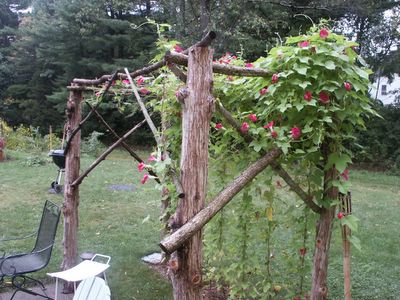For one thing, Lloyd’s long border at his estate at Great Dixter is 200 feet by 15 feet, so many of the effects which he finds practical are not possible in any garden likely to be owned by the bourgeoisie. Further, he gardens in
So taken altogether, in any combination of 3 plants you might consider, it’s a safe bet that 1 of them either can’t be grown in your location, or will require extraordinary levels of coddling to get through the winter. At some level there’s nothing wrong with that; who hasn’t at least considered growing Dahlias or Gladioli, which must be dug up, but can then be stored in most basements? However, his planting schemes are more labor intensive than this. The semi-hardy and tropical plants he loves must be dug up, or have cuttings taken, and many are wintered under glass; to do this for all of his many varied plants, he apparently has at least 3 different temperatures in his greenhouses or cold frames.
Normal (i.e., not superhuman) gardeners use biennials and short-lived perennials (the ones which seed themselves to death) such as Lupines, many Dianthus, Digitalis (foxglove) and Lychnis coronaria, as relatively easy self-sowers, performing enough dead-heading to keep seedlings to a modest level, and hopefully to keep the mother plant alive as well. For Lloyd and his head gardener, Fergus Garrett, the chosen method for all of these but the Lychnis (rose campion) is generally to sow seeds in summer, pot them up and put in a cold frame in October, bed out the next April or May, then rip out the plants as soon as their blooms have faded. Naturally his Lupines make mine look diseased. Damn him to hell and all that. For fuzzy-leaved Verbascums, which he winters in their final positions, he actually suspends a plate of glass over their crowns to keep them dry so they don’t rot!
All that said, his plant combinations are exquisite, and many of them are obtainable by most gardeners in temperate climates. More important, the principles he espouses, the color combinations, and the methods of succession among broad types of plants, are all transferable to less intensive methods, or to other plants which are more practical for your situation. Further, I defy anyone to read this book without discovering several new plants he will plan to try out. I am made newly aware especially of several with true- and deep-blue flowers. Buy or borrow this book, but also consider his older books, The Adventurous Gardener and The Well-Tempered Garden. They have essentially no illustrations, but a wealth of cultural information and design ideas and critiques of many plants and cultivars.
The Adventurous Gardener
The Adventurous Gardener, which I obtained for $4.98 in the bargain book section at New England Mobile Bookstore, has long graced my shelves. It provides a brilliant gardener's take on any number of practical, as well as aesthetic, judgments. The first 11 chapters concern maintenance and propagation, such as "Unusual Ways with Rose Cuttings," “Maintaining Mature Hedging,” and "Some Reactions to Cutting Back" (which covers the results of radical pruning on scores of genuses of shrubs and trees).
The next 8 chapters cover trees and shrubs, Lloyd’s experience and opinions of hundreds of species and cultivars, and the best ways, culturally and aesthetically, to use them in the garden. The rest of the book covers a variety of herbaceous plants, design concepts, the theories of Gertrude Jekyll, “Planning a Border,” you name it. Of course, the book, at 250 pages, is not comprehensive. For that matter, Lloyd’s The Well-Tempered Garden is in a sense basically the same book, except that there is very little overlap. Each is a series of essays which stands on its own. (Similarly, the estate of the late Henry Mitchell has 3 such books out, made up of his newspaper gardening columns; but Mitchell’s columns are shorter and more about literary style than detail, and his 3 books overlap each other considerably.)
This book’s greatest weakness: it only has 18 low-resolution black & white photos. These are in the book's center, and do little to illustrate the text. So in order to follow many of the chapters, which concern specific varieties of, say, crabapple trees, or concern combinations of plants, you will have to have the A-Z Encyclopedia of Garden Plants or a similar reference at hand. That said, this keeps the book small and dirt cheap (as little as a dollar used via Amazon). I suppose I could, for lack of hundreds of glossy color photos, rate the book less than the perfect 5 stars, but I can’t see criticizing a book for not being what it is not, especially when it is so good at being what it is.











